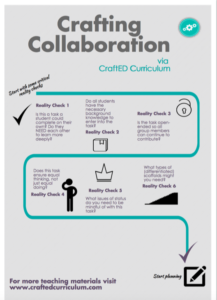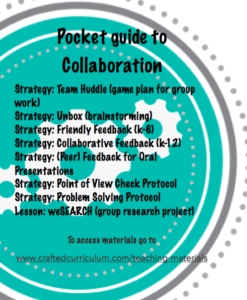One of the many reasons I love PBL is that it provides so many opportunities for students to develop skills they need to be successful in life. Collaboration is a great example. Project work often requires students to work together through a process, problem, or product design and creation, making collaboration commonplace in project-based classrooms. And effective collaboration is one of the highly prized skills of deeper learning like PBL, leading to better communication and enhanced critical thinking and creativity.
Chances are if you are reading this blog you are pretty sold on “the why” of student collaboration. “The how” is another matter. Simply setting up working groups will not necessarily lead to effective collaboration and equitable learning for all students – picking teams is a long way from being a winning team!
The Power of Protocols
Want to make equitable collaboration happen in your classroom? Consider protocols.
Collaboration protocols have a common theme of small groups of students engaging in the exchange of ideas and perspectives. Protocol formats vary – from verbal to silent, artistic to written, short to long, sedentary to active. They happen as early as kinder and go on to be used with adult learners. Most importantly, protocols have an important place in a collaborative classroom, and here is why:
- Protocols ensure that all students have equal air time to speak, and be heard. We have all experienced group members who have much to share, limiting the space for others to share ideas or concerns. Protocols can provide set times for each individual to speak, and if that time is not needed, the space is held to honor the student who “has the floor”; meaning silence is held for the allotted time designated in the protocol. 99% of the time when silence becomes deafening for a group, the student who “has the floor” will end up sharing an additional thought or idea that would have otherwise been rushed over.
- Group members see each other in new ways when each group member has multiple opportunities to speak. Throughout these speaking opportunities, different types of intelligences are allowed to shine and perspectives that each student brings to the conversation are more likely to be heard.
- Protocols provide a structure that implicitly teaches the skill of listening. Protocols often build on individuals’ ideas, therefore requiring each group member to be present and listen for a collective purpose, the group goal, not just their own agenda.
- Protocols provide a framework for thinking and processing, which for some students can easily get lost when working in a group. Individuals have different needs when it comes to processing, but protocols ensure a mechanism for a group to collectively process their learning, rather than racing to the finish with the fastest member.
- Protocols give a structure for healthy discourse. Mechanisms such as norms, roles and sentence frames are part of the protocol process, which creates a safe space to individuals to respectfully disagree. Equitable group work doesn’t mean that everybody always agree and have the same experience. A better goal is that all members have the same opportunity to learn from their peers and be valued for what they contribute.
Tips for Your Craft
Ideas for when it may be a good time to try a protocol:
- When brainstorming a project idea
- When a learning activity will tell you where students are in the learning
- When a pivotal decision needs to be made in a group
- When there is potential for diverse perspectives, or possible disagreement
- When you are in the messy middle of a project. Read more on this here.
Additional lessons learned from the trenches:
- Model what the protocol looks like for the class by using a fishbowl protocol
- Establish norms as a class for how students should interact in their group
- Be upfront about your expectations for the group behavior and outcomes
- Be present! Observe each group, assess their learning and offer diagnostic feedback.
- Provide students with roles to keep them engaged and accountable during the protocol
- Debrief! debrief! debrief! Analyze the effectiveness of the protocol with the class. Revise.
A few of my favorite protocols:
For more resources on planning group work, use this resource and visit https://craftedcurriculum.com/shop/?orderby=pa_student-collaboration_ASC .

